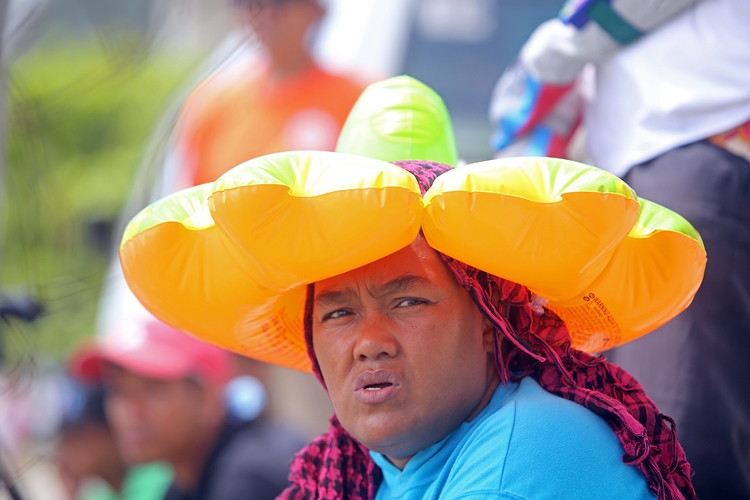Weather bureau asks public to take ‘extreme caution’ under the sun

A woman uses a beach floatation device like a hat to shield her from the scorching heat while watching over her children swimming at the foot of the old Mandaue-Mactan bridge in Mandaue City. (CDN PHOTO/TONEE DESPOJO)
The rising mercury in thermometers may not be the only thing Cebuanos need to watch as they sweat in the summer heat.
The heat in the past few days is cause for “extreme caution” said the Philippine Atmospheric Geophysical and Astronomical Services Administration (Pagasa).
People “could experience heat cramps and heat exhaustion. Continuous exposure could result in heat stroke,” Pagasa said.
The heat index in Metro Cebu ranged from 30.5 degrees Celsius to 38 degrees last Friday.
The advice is familiar: People should stay indoors as much as possible, drink plenty of water regularly and eat light.
The summer heat could go on until the third week of May and increase by 2 to 3 degrees Celsius in the coming days, said Pagasa Mactan acting chief Al Quiblat.
In urban areas, pollution, car emissions and concrete pavement intensify the heat.
“We can expect more hot afternoons and hot nights,” Quiblat told Cebu Daily News.
Temperatures starts to rise around 9 a.m. and eases up at dawn. The hottest part of the day is 2 p.m. to 3 p.m., he added.
Quiblat said the heat is part of summer, and not the El Niño yet.
“We expect the onset of El Niño by June, but the actual impact of a drought may be in the last quarter of the year,” he said, adding that rainfall may still be normal by June.
“Avoid being exposed to the sun too much and keep hydrated by bringing a bottle of water,” Councilor Dave Tumulak said.
The head of the Command Control Center (C3) said people can call 166 in case of an emergency, like heat stroke.
C3 emergency health personnel are stocking up on supplies to treat victims of extreme heat exposure.
The heat index or “human discomfort index” measures the “apparent” temperature which people feel affecting their bodies.
“High air temperatures and high relative humidity will give high apparent temperature indices,” said Pagasa.
A human discomfort index or heat index of 32 degrees to 41 degrees Celsius means people should exercise extreme caution when under the sun, Pagasa said.
The heat index in Metro Cebu ranged from 31.1 to 38.1 degrees C last Saturday and 30.7 to 37.7 degrees C yesterday.
Today will be similar at 30.6 to 38.6 degrees C and 30.9 to 38 degrees C tomorrow. Forecast air temperature for today is 25 – 32°C, while it would be 27-33°C tomorrow.
Timely preparation
The El Niño phenomenon is expected to start in June.
To prepare for it, the Cebu City government set aside P10.3 million to respond to the impact, including drought in upland farms.
“Barangay officials should also strengthen garbage collection. We don’t want stagnant water in canals and drainage so as to prevent cases of dengue,” he said.
A total of P5 million was also set aside from the disaster fund this year, through the City Health Department, for the anti-dengue campaign.
Farmers were advised to plant seeds that are more resilient to extreme heat.
Tumulak proposed to the Cebu City Council a P5.28 million budget for agricultural equipment and veterinary medicines to aid farmers in at least 30 mountain barangays.
Around P2 million will be used to purchase heat-resilient seeds to be distributed to farmers, he said.
The proposal was referred for study by the committee on budget and finance.
The amount of P5,286,400 was recommended by the City Agriculture Department and the Department of Veterinary Medicine and Fisheries.
Tubig Project
The “Tubig Project” of the City’s Department of Public Services will also be useful in locating water sources, installing artesian wells and buying hoses and water tanks.
Engr. Rufina Adlawan, head of the Tubig Project, said the survey started last March has been completed, they then consulted mountain barangay officials on equipment they might need like tanks, hoses and drums.
“Hoses will be placed in waters sources like natural springs. The water will then be stored in tanks to be distributed to different sitios,” Adlawan said.
The stored water will then be used by residents and farmers affected by the El Niño.
The Metro Cebu Water District has reported lower levels in the Jaclupan weir in Talisay and the Buhisan Dam.
Most of Metro Cebu’s water is pumped from underground, not from surface sources like dams and weirs.
Nevertheless, MCWD advised consumers to store water during off-peak hours, mostly at night when water usage is lower. During peak hours in the day, water flows more slowly from faucets as pressure decreases with the sheer volume of users.
Disclaimer: The comments uploaded on this site do not necessarily represent or reflect the views of management and owner of Cebudailynews. We reserve the right to exclude comments that we deem to be inconsistent with our editorial standards.
